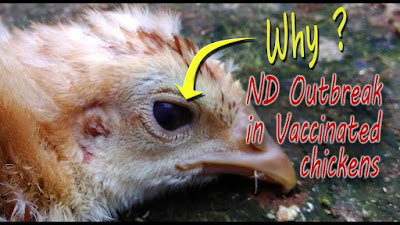Newcastle disease | Cause | Symptoms | Prevention | Cure
Newcastle disease (ND) is a highly contagious viral disease of domestic poultry, cage and aviary birds, and wild birds. Virulent Newcastle disease is a serious economic threat to the poultry industry
ND viruses have varying capability (pathogenicity) to produce clinical disease in domestic poultry, with some virus strains showing high levels of pathogenicity while other strains produce no disease and are classified as nonpathogenic (avirulent).
Cause
A virus of the family Paramyxoviridae
Life cycle
The incubation period is usually 5-6 days but may vary from 2-15 days.
Affected animals
All avian species, both domestic and wild
Symptoms
ND is usually seen in domestic poultry as a rapidly fatal, high-mortality condition characterised by gastrointestinal, respiratory or nervous signs. In other avian species, the disease produced by virulent ND viruses ranges clinically from inapparent to a rapidly fatal condition.
The severity of the symptoms depends on the strain of the virus and the age and health of the bird.
The ND virus produces 4 broad clinical syndromes.
Viscerotropic velogenic ND
This clinical syndrome appears suddenly and spreads rapidly.
Symptoms are marked depression, loss of appetite, sharp drop in egg production, increased respiration, swollen heads, blue combs, and, often, a profuse green diarrhea that leads to dehydration and collapse
Birds may die within 2 days. Birds that survive the initial phase often develop nervous signs such as twisted necks and muscle twitching. Up to 90% of birds may die.
Neurotropic velogenic ND
Severe respiratory and nervous signs predominate, including coughing and gasping, head tremors, wing and leg paralysis and twisted necks.
Depression, loss of appetite and a drop in egg production also occur. Between 10-20% of adults and a larger proportion of younger birds may die.
Mesogenic ND
Signs are mainly respiratory, with coughing but no gasping.
Other signs include depression, loss of weight and decrease in egg quality and production for up to 3 weeks.
Nervous signs may develop late in the course of the disease.
Death rates are about 10%.
Lentogenic ND
Symptoms are mild or absent, and include mild respiratory signs, impaired appetite and a drop in egg production.
No nervous signs occur and deaths are usually negligible.
In humans
A mild form of disease can affect people, causing headaches, flu-like symptoms and conjunctivitis.
How it is spread
ND spreads easily by contact with infected or diseased birds. The virus is excreted in manure and is expired into the air. Other sources of infection are contaminated equipment, carcasses, water, food and clothing.
Control
Vaccination for Newcastle disease (ND) is routinely practiced in countries where virulent strains of the Newcastle disease virus (NDV) are endemic and in countries where virulent strains do not exist but ill-timed infection by a low virulent field strain may have significant economic consequences for the producer. The types of vaccines and vaccination schedules used vary depending on the potential threat, virulence of the field challenge virus, type of production, and production schedules. A combination of live and inactivated ND vaccine, administered simultaneously, is shown to provide better protection against virulent NDV and has been successfully used in control programs in areas of intense poultry production. A potential limiting factor in the use of live vaccines to control virulent ND is that live virus can interfere with surveillance and laboratory diagnosis. However, a new assay, the real-time reverse transcriptase-polymerase chain reaction (RRT-PCR), differentiates low virulent from virulent NDV, thus minimizing the disadvantage of live virus vaccines in the face of an outbreak and may facilitate the use of such vaccines to control outbreaks of virulent ND in the future.
Tags:
Poultry

